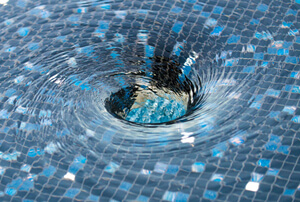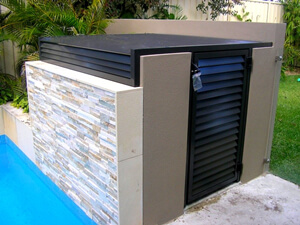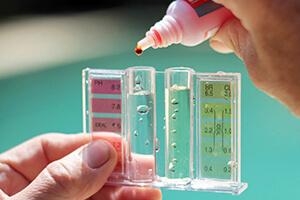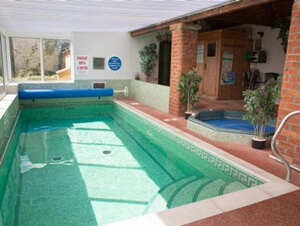It’s the interim between spring and summer. Weather looks like going to rain on and off in a day. People who are keen on swim may have noticed the upcoming problem that rain will disturb the chemistry balance of pool water. In this article, BluwhaleTile is going to give you some insightful thoughts about how to deal with the rain and get pool water back to good for swimming.
 Step One: Low Down Pool Water Level
Step One: Low Down Pool Water Level
It’s a common sense that rain can increase the height of pool water especially after being through a downpour. The first thing you should do is to drain the redundant water so that water line can be brought back to where it is supposed to be. If your pool has already installed with pool border tile, that’s even more convenient. Just adjust the water level little below the border.
Step Two: Check Pool Functional Equipments

It’s a vital matter to make sure all equipments function well after the rain, though they’re usually well sheltered. Yet, swimming pools more or less have leaking problem, particularly for those are lack of careful maintenance. If the joint of pool and equipment cracks or somewhere unknown breaks, rain and leaking pool water may result in equipment malfunction and even worse a chronic permanent damage to the pool. Read our published article Swimming Pool Leaking Problem, Things Contractors Don’t Tell you will have more details. Further, there are two main systems you should focus on – circulation system and filtration system. These two is the key to keep water clean and fresh. You should make sure water can flow smoothly through the equipments. To achieve this, skimmer baskets and filter pump baskets should be clean without accumulated debris and dirt. Finally, check the pressure of your filter to ensure it is at the normal level.
Step Three: Do Chlorine And pH Test

After making sure equipments are all in a good function, then it’s turn to do a test on pool water. Pool water is very likely to be polluted by the rain. That further produces negative impact on chemical indexes like chlorine and pH. Generally speaking, pH of the pool water should be controlled within 7.4-7.5 to ensure the activity of chlorine. If pH is increasing to 8.0 or higher, chlorine will be inactivated and lose its capability of cleaning and disinfection. Then algae and bacteria will breed in your pool water with no restraint. That not only makes pool maintenance harder, corrode pool tiles ceramic and any other materials that can be subjected to chemical reaction. If the test shows your pH is higher than the standard, add acid to lower the pH. You may ask how to see there is enough active chlorine in the pool water or not. Industry gives a standard. It is 2-4 ppm minimum. You may like to read more about chemistry balance, please read our published article Helpful Tips For New Pool Owners: How To Maintain Water Chemistry Balance?
Step Four: Clean Pool Water 
After being sure circulation, filtration and chemistry are back in normal operation, you have to do the final step, that is, open up all the equipments for water cleaning. It takes different lengths of time depending on the type of filter you have. During the process, you’re in fact doing double check on the equipments and you may also find out other problems besides this.
BluwhaleTile is a brand that enjoys high reputation among pool tile manufacturers, who are striving to offer you a great variety of quality pool tile that can save your time and cost of pool maintenance. Welcome to visit us at http://www.bluwhaletile.com/ for more info.